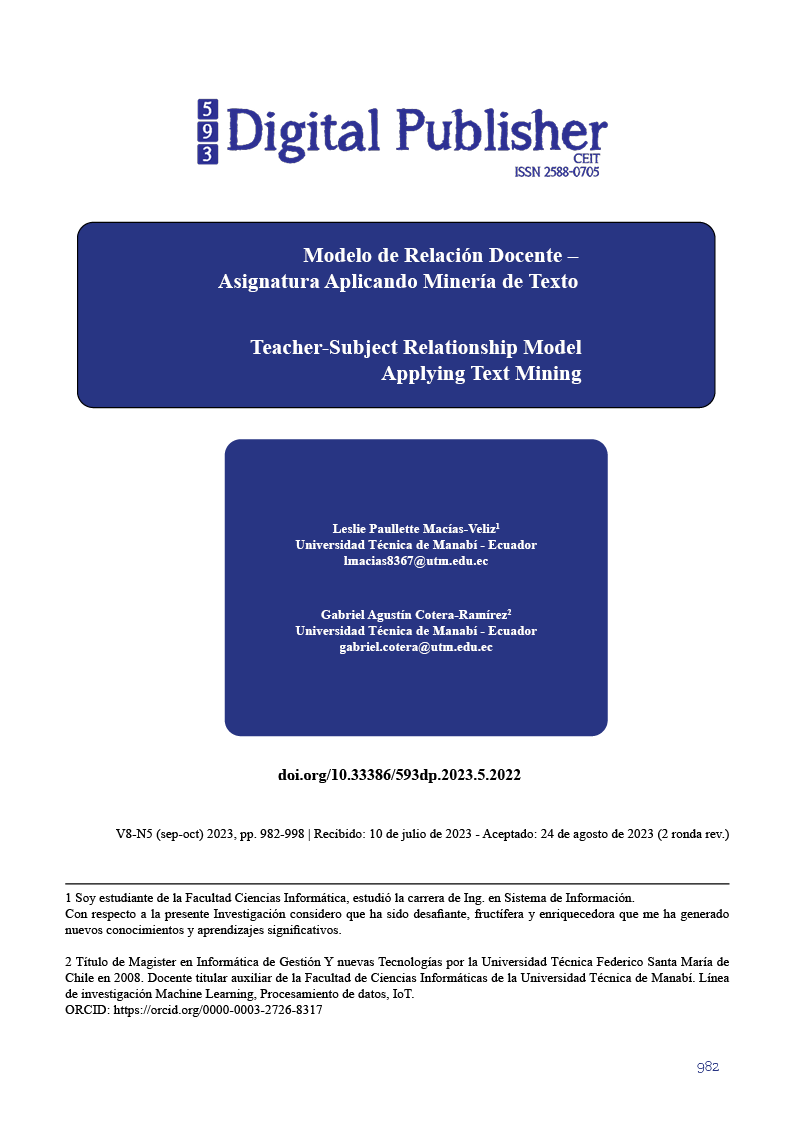Teacher-Subject Relationship Model Applying Text Mining
Main Article Content
Abstract
The study focuses on the relationship between the professional titles of university professors and the subjects assigned to them. The methodology used in the study is based on text mining and frequency analysis of words. A descriptive documentary methodology was employed, using empirical methods and comparative tools. Documents related to the subjects and the profiles of the teachers were collected, and processes of cleaning, vectorization, and similarity were performed on the texts.
The results obtained showed a significant correlation between the teaching profile and the contents of the subjects. An average correlation of 80% was found between the professors and the contents of the subjects in the Information Systems program. The same analysis was conducted for the professors in the Information Technology program, and an average correlation of 82% was found. Additionally, the correlation was analyzed in greater detail for specific teachers and subjects, revealing high levels of correlation, with percentages ranging from 82% to 88%.
The study utilized techniques such as word2Vec and cosine similarity to calculate the proximity between words and related concepts. The results support the importance of using text mining methods to analyze and understand the relationship between professors and subjects, providing a solid foundation for continuous improvement in educational management in the field of information technology. The study highlights the importance of implementing a decision-making culture based on the data generated in universities.
Downloads
Article Details

This work is licensed under a Creative Commons Attribution-NonCommercial-ShareAlike 4.0 International License.
1. Derechos de autor
Las obras que se publican en 593 Digital Publisher CEIT están sujetas a los siguientes términos:
1.1. 593 Digital Publisher CEIT, conserva los derechos patrimoniales (copyright) de las obras publicadas, favorece y permite la reutilización de las mismas bajo la licencia Licencia Creative Commons 4.0 de Reconocimiento-NoComercial-CompartirIgual 4.0, por lo cual se pueden copiar, usar, difundir, transmitir y exponer públicamente, siempre que:
1.1.a. Se cite la autoría y fuente original de su publicación (revista, editorial, URL).
1.1.b. No se usen para fines comerciales u onerosos.
1.1.c. Se mencione la existencia y especificaciones de esta licencia de uso.
References
Ayyadevara, V. K. (2018). Word2vec. En V. K. Ayyadevara, Pro Machine Learning Algorithms (pp. 167-178). Apress. https://doi.org/10.1007/978-1-4842-3564-5_8
Barrio Pareja, E. E. B. (2014). Minería de texto para el análisis de la colaboración en SIENA. 5(10), 1-61.
Benítez, C. A. F. (2016). Herramienta informática con minería de texto para la caracterización psicosocial de estudiantes y grupos universitarios. 1-75.
Betancourt Bethencourt, J. A., Acao Francois, L., & Álvarez Escoda, M. (2016). Entrenamiento de estudiantes de Medicina en investigaciones cualitativas y minería de texto durante el 2015 en Camagüey. Educación Médica Superior, 30(3), 669-677.
Bin Mat, U., Buniyamin, N., Arsad, P. M., & Kassim, R. (2013). An overview of using academic analytics to predict and improve students’ achievement: A proposed proactive intelligent intervention. 2013 IEEE 5th Conference on Engineering Education (ICEED), 126-130. https://doi.org/10.1109/ICEED.2013.6908316
Consuegra, A. A., Salazar, Y. M., García, J. H., & Vizcaino, D. H. (2016). MINERÍA DE TEXTO COMO UNA HERRAMIENTA PARA LA BÚSQUEDA DE ARTÍCULOS CIENTÍFICOS PARA LA INVESTIGACIÓN. . . pp., 7(1), 8.
Contreras Barrera, M. (2015). Minería de texto: Una visión actual. Biblioteca Universitaria, 17(2), 129-138. https://doi.org/10.22201/dgb.0187750xp.2014.2.72
Digión, L. B., Álvarez, M. M., Digión, L. B., & Álvarez, M. M. (2021). Experiencia de enseñanza-aprendizaje con aula virtual en el acompañamiento pedagógico debido al Covid-19. Apertura (Guadalajara, Jal.), 13(1), 20-35. https://doi.org/10.32870/ap.v13n1.1957
Dikaiakos, M. D., Katsifodimos, A., & Pallis, G. (2012). Minersoft: Software retrieval in grid and cloud computing infrastructures. ACM Transactions on Internet Technology, 12(1), 2:1-2:34. https://doi.org/10.1145/2220352.2220354
Duarte, J., Talero, L., & Arias-Tabares, J. (2019). Identificación de estrategias académicas aplicando minería de texto: El caso de la asignatura Finanzas y Presupuestos. Espacios, 40, 9.
Espíritu-Sandoval, K. Y. E. (2016). MAESTRO EN SISTEMAS COMPUTACIONALES. 2(3), 1-71.
Florio, N. (2022). Las palabras de la educación española: Una experiencia de minería de textos: Análisis lingüístico diacrónico de las leyes educativas con R. HUMAN REVIEW. International Humanities Review / Revista Internacional de Humanidades, 13(1), Article 1. https://doi.org/10.37467/revhuman.v11.4001
Garrido, C. D., Orta, G. del C. L., Rivilla, A. M., & Méndez, E. R. (2014). Las competencias docentes: Diagnóstico y actividades innovadoras para su desarrollo en un modelo de educación a distancia. REDU. Revista de Docencia Universitaria, 12(1), Article 1. https://doi.org/10.4995/redu.2014.6431
Han, J., Kamber, M., & Pei, J. (2012). Data mining: Concepts and techniques (3rd ed). Elsevier/Morgan Kaufmann.
Kansanen, P. (2003). Studying–the Realistic Bridge Between Instruction and Learning. An Attempt to a Conceptual Whole of the Teaching-Studying-Learning Process. Educational Studies, 29, 221-232. https://doi.org/10.1080/03055690303279
Kumar, S., & Saeed, M. (2018). Applications of Educational Data Mining and Learning Analytics Tools in Handling Big Data in Higher Education: Trends, Issues, and Challenges. https://www.researchgate.net/publication/326554623_Applications_of_Educational_Data_Mining_and_Learning_Analytics_Tools_in_Handling_Big_Data_in_Higher_Education_Trends_Issues_and_Challenges
Lang, C., Siemens, G., Wise, A., Gašević, D., & Merceron, A. (2017). Handbook of Learning Analytics—Second edition. Society for Learning Analytics Research (SoLAR). https://www.solaresearch.org/publications/hla-22/
Navarro, I. S. (2021). Prototipado Rápido de Minería de Texto Usando Campos Conceptuales Fast Prototyping for Text Mining Using Conceptual Fields. 2(25), 11-38.
Peña-Ayala, A. (2014). Educational data mining: A survey and a data mining-based analysis of recent works. Expert Systems with Applications, 41(4, Part 1), 1432-1462. https://doi.org/10.1016/j.eswa.2013.08.042
Pérez Abelleira, M. A., & Cardoso, C. A. (2010). Minería de texto para la categorización automática de documentos. 5, 11-45.
Rivero, S., David, V., Humberto, J., Ester, M., Alejandro, L., Alejandro, A., Brian, C., Facundo, Á., Nicolás, P., & Noelia, C. (2020). Aplicación de Técnicas Descriptivas de Minería de Textos sobre Contenido Digital Realizando Análisis Inteligente. 2(5), 279-283.
Romero, C., & Ventura, S. (2013). Data mining in education. Wiley Interdisciplinary Reviews: Data Mining and Knowledge Discovery, 3(1), 12-27. https://doi.org/10.1002/widm.1075
Ruiz-Cornejo, N., Arriagada-Benítez, M., Ruiz-Cornejo, N., & Arriagada-Benítez, M. (2022). Análisis estilométrico en Python aplicado a epistolarios de la premio nobel de literatura Gabriela Mistral. Ingeniare. Revista chilena de ingeniería, 30(2), 229-238. https://doi.org/10.4067/S0718-33052022000200229
Shahiri, A. M., Husain, W., & Rashid, N. A. (2015). A Review on Predicting Student’s Performance Using Data Mining Techniques. Procedia Computer Science, 72, 414-422. https://doi.org/10.1016/j.procs.2015.12.157
Strech, P., Cruz, L., Soares, C., Mendes, J., & Abreu, R. (2015). A Comparative Study of Classification and Regression Algorithms for Modelling Students’ Academic Performance. 3. https://www.researchgate.net/publication/278030689_A_Comparative_Study_of_Classification_and_Regression_Algorithms_for_Modelling_Students%27_Academic_Performance
Talamé, L., Cardoso, A., & Amor, M. (2019). Comparación de herramientas de procesamiento de textos en español extraídos de una red social para Python. 53-67.
Temesio, S., GarcÃa, S., & Perez, A. (2021). Rendimiento estudiantil en tiempo de pandemia: Percepciones sobre aspectos con mayor impacto. Revista Iberoamericana de Tecnología en Educación y Educación en Tecnología, 28, 359-369.
Vargas Guarín, J. D., Barona Jiménez, M. A., & Garcia Beltrán, F. E. (2021). Doctor mining: Sistema text mining para localizar información sobre enfermedades pulmonares. https://repositorio.unbosque.edu.co/handle/20.500.12495/7146
Vargas Pulliquitín, M. F. (2018). Minería de texto de la web, de opinión pública y hechos referentes al barrio La Floresta [BachelorThesis, Quito, 2018.]. http://bibdigital.epn.edu.ec/handle/15000/19574
Wauer, M., Meinecke, J., Schuster, D., Konzag, A., Aleksy, M., & Riedel, T. (2011). Semantic Federation of Product Information from Structured and Unstructured Sources. IJBDCN, 7, 69-97. https://doi.org/10.4018/jbdcn.2011040105
Xiao, X., Xu, H., & Xu, S. (2015). Using IBM SPSS modeler to improve undergraduate mathematical modelling competence. Computer Applications in Engineering Education, 23(4), 603-609. https://doi.org/10.1002/cae.21632
York, T. T., Gibson, C., & Rankin, S. (2015). Defining and Measuring Academic Success. 20(5), 1-21. https://doi.org/10.7275/HZ5X-TX03
Zhañay, M. B. A. (2016). MINERÍA DE TEXTO EN MEDIOS SOCIALES. CASO DE ESTUDIO DEL PROYECTO TRANVÍA DE CUENCA. Universidad del Azuay.



